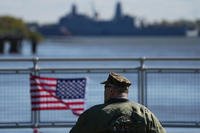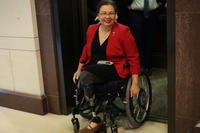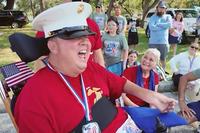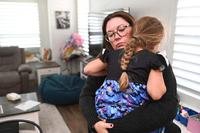Kathy Kinane of Camillus, N.Y., said her dad, Ken Budd, and her uncle, Robert, had a “wonderfully close” brotherly connection.
Though he was 10 years younger, Ken idolized his older brother.
“My uncle would take him places and cover for him,” Kinane remembered. “They were always pals.”
World War II was the only force that could have separated them.
But not even that, nor Robert’s death in the Pacific Theater in 1942, could break their brotherly bonds.
Kinane tells a story from 1987 when Robert visited Ken in a dream.
“Hi,” he told Ken. “Got to go now. But I’ll get back to you on September 26.”
Ken did not think anything of the dream, nor the oddly specific date.
Later that year, he was leading a fishing tour on the Oswego River when the water level was suddenly lowered by Niagara Mohawk after someone had a medical emergency upstream. When the water was allowed to rise, Ken’s boat was caught in a whirlpool and capsized.
“Budd suffered a fractured vertebrae, cuts, bruises, and trauma, according to legal documents,” the Herald American reported on Jan. 24, 1988.
Three times Ken tried moving while lying on the bottom of the river but could not move.
Suddenly, there was “a commanding voice.”
“Put your arms out,” it said. “Try one more time.”
Ken rose to the surface of the river and grabbed hold of another boat. The date was September 26.
“I get goose bumps thinking about it,” Kinane said.
The brothers were inseparable, even in death.
By 1987, Ken had already made two trips to Guadalcanal, the site of the fearsome battle where his brother lost his life on Aug. 27, 1942, to find Robert’s remains.
Now, after years of toil, this Syracuse war hero is finally coming home, to be buried beside his kid brother and buddy.
***
On Jan. 9, 1942, Syracuse experienced its largest single day of Marine recruitment since war was declared following Pearl Harbor.
Robert Joseph Budd, 20, of 6400 South Salina St. in Nedrow, was among the 45 men sworn in that day.
He had attended Onondaga Academy and was a steelworker at Globe Forge Incorporated. His father, Seeley, worked for the Western Union office inside the Herald-Journal newspaper.
Budd was assigned to Charlie Company, First Battalion, 5th Marines as an automatic rifleman. Newspaper reports described him as a sharpshooter and “an expert with an automatic rifle and machine gun.”
On April 13, 1942, the Herald-Journal reported that Budd returned to the Marines at North River, North Carolina after “a short leave passed at the home of his parents.”
It was probably the last time the brothers saw each other.
Four months later, on August 7, U.S. Marines began “Operation Watchtower,” the first American offensive of the war, by landing on Guadalcanal, one of the Solomon Islands.
Budd’s 5th Marines landed 20 days later along the northern coast. The fighting was intense.
“We all jumped for cover, but several of the men were hit,” said Captain William Hawkins. “You couldn’t see the (Japanese), so we began firing in the direction from which their fire had come.”
With his best friend in the service by his side, Private Thomas Phillips, Budd tried to get into a good position to fire.
Budd was shot in the chest and fell to the ground. Phillips tried to help but he too was shot through the body. They died together.
The next morning, the friends were buried side by side in a coconut grove. A burial party noted a broken-down fence as a nearby landmark and made sure that both were buried with dog tags. However, neither grave was located by post-war search parties.
News of his death arrived at his parents’ doorstep a month later. Budd’s death notice in the Herald-Journal said that “information as to where he met his death could not be disclosed at this time.”
“I can still hear my mother’s screams,” brother Ken wrote in a letter to the newspaper in 1991.
An editorial on Sept. 25, 1942 said the following about Private Robert Budd:
“We know how poignant is the grief of the parents at this hour. But they have the right to cherish a deep and everlasting pride in the character of their son and the brave, fine record he made. At the same time, we wish to emphasize that there was a glory in this young man’s devotion and sacrifice which shall shine through the years, warming the hearts of those who grieve today.”
In a letter to the editor, Seeley Budd wrote this about his son:
“Our love of Bob was unbounded and our pride in the knowledge that he went out fighting in defense of those he loved is just as great. We offer this thought as a source of some consolation to others whose loved ones have passed on down the same bright trail to rest.”
On Memorial Day weekend 1946, Elmwood Presbyterian dedicated blue spruce trees in memory of the 11 of the 278 soldiers from the congregation who had died during World War II.
Robert Budd was among them.
For decades, it was the only memorial to him locally.
“Uncle Bob was not just a black-and-white photo growing up,” Kathy Kinane remembered. “He was a huge part of the family.”
Her father Ken would not let his brother be forgotten.
“We always knew him,” she said. “We thought, ‘What an awesome uncle he would have been.’”
Ken Budd followed in his brother’s footsteps and joined the Marines during the Korean War.
“He never saw a battle,” Kinane said, “and he was angry about that.”
After being honorably discharged, he got married and had four children and settled in Syracuse’s Valley section. He retired as a district chief with the Syracuse Fire Department. He later became a charter boat captain on Lake Ontario and Oswego and Salmon Rivers.
“My father was a remarkable guy,” Kinane said. “He was smart. And an expert on anything he put his mind to.”
Quite often he thought about his older brother and how to bring him home.
“It became dad’s life mission,” Kinane said.
Ken Budd started researching his brother’s unit and movements at Guadalcanal. He got Robert’s records from the National Personnel Record Center and visited the National Marine Corps Museum. He tried tracking down the comrades in his brother’s unit.
Ken made “hundreds and hundreds of phone calls, letters and personal visits with ex-Marines and others who might possibly help him,” a 1989 Post-Standard article said.
Divine guidance once again played a role.
Ken was visited by Robert in a dream.
“Get a hold of Charlie Wolff,” Ken was told. Then he was given an address and phone number.
Ghosts are not always perfect. The phone number and address were wrong. But Charlie Wolff was Robert’s squad leader, still living in Virginia.
With information provided by Wolff, Ken was able to retrace his brother’s final steps at Guadalcanal in 1985. However, he could not find his burial spot.
Ken asked a local priest if he could have a plaque dedicated to his brother at a church which faced towards the direction where Robert had fallen.
A year later, in 1986, he returned with the plaque which read:
“Resting in peace on these sacred grounds are Robert J. Budd and Thomas Phillips, American Marines, who died valiantly for their country. The Budd Family.”
Ken returned to the site in 1989, again in 1993, and for the last time in 2008.
“He became an expert,” Kinane said of her dad. “He studied aerial maps and made friends.”
His brother’s former Japanese adversaries even helped in the search.
But he never found Robert.
Ken Budd’s health began declining. He wanted to return to Guadalcanal one last time, but his family stopped him.
“I promise you,” his daughter promised him. “If they find him, we will get him home.”
Ken Budd died on Feb. 22, 2021.
Incredibly, almost beautifully, one month later to the day, a construction crew laying water pipes outside The Ofis restaurant at Guadalcanal requested an explosive ordnance expert to their work site after human remains and American military equipment were found.
Half a world away, Kinane was left a message on her answering machine.
Robert was found.
“I was freaking out, crying,” she said. “I told my brothers. I told my kids …”
In 2022, Robert Budd and Tommy Phillips were pulled from their graves and an entire process involving anthropologists, scientists, and morticians started. His remains, including his dog tags, a bit of his helmet and some buttons, were brought to Pearl Harbor for identification.
Ken Budd had hoped that his brother would be buried at Arlington National Cemetery, possibly alongside Phillips.
His children, though, had different ideas.
Robert and Ken, the kid brother who went to such extraordinary lengths to bring him home, should be reunited at Nedrow’s Valley Cemetery.
Home, finally together.
“That was more important,” Kinane thought.
On Thursday, Oct. 9, Robert Budd is set to return to New York state.
His remains are due to land at Rochester and will then be given a Marine escort back to Syracuse, returning to his hometown after 83 years away.
There will be a memorial service at Buranich Funeral Home, 5431 West Genesee Street, Camillus, at 11 a.m. on Friday, October 10.
He will be buried with full military honors at Valley Cemetery, 2500 Valley Drive, Nedrow.
“Dad, he’s home,” Kinane said. “We did it! Robert’s finally home!”
© 2025 Advance Local Media LLC.
Visit syracuse.com.
Distributed by Tribune Content Agency, LLC.













